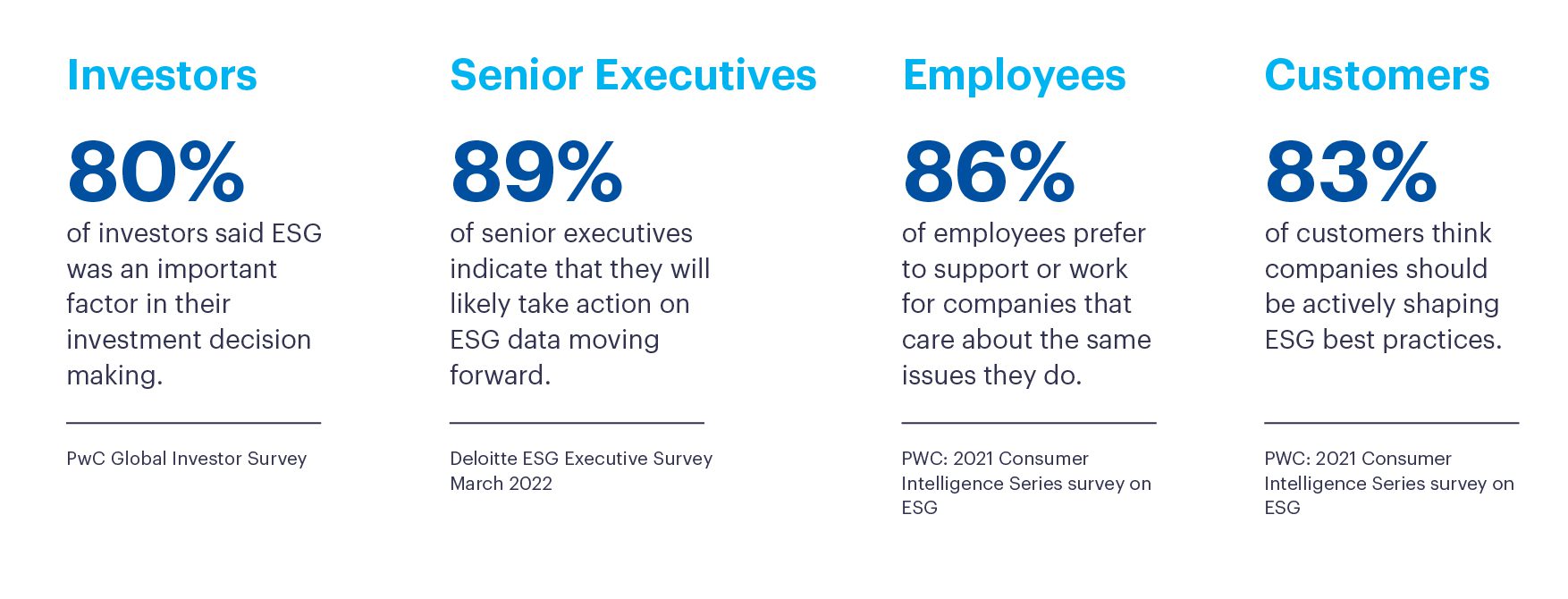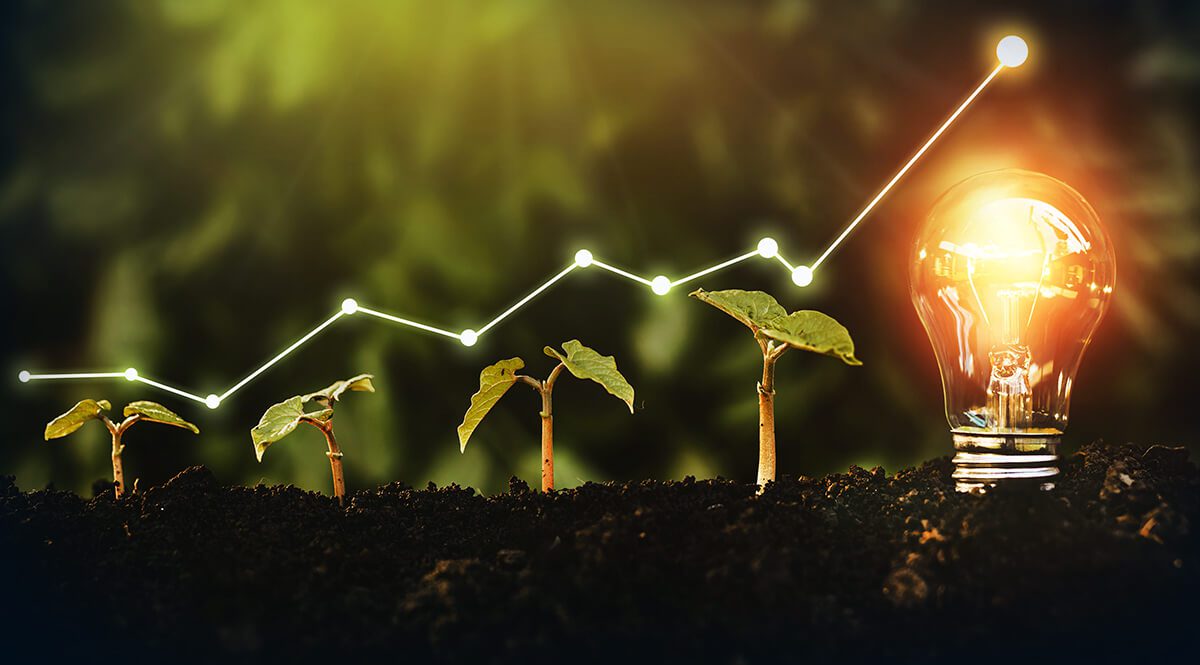Understanding that investment into ESG initiatives can create long-term value for an organisation is just the first step on your ESG journey; doing something about it by creating a roadmap that guides an ESG program to maturity is a longer path that requires structure.
This evaluation of an organisation’s collective conscientiousness for ethical social and environmental behaviour has evolved into a key metric that businesses are benchmarked against. Driving this change is today’s ethically minded society, for whom products and services that prioritise people and the planet are a prerequisite. Joining this chorus for greater transparency on how businesses impact society and the environment are regulators and investors – who are forcing organisations to structure processes to ensure sustainability.
With the pressure to satisfy ESG concerns greater than ever, businesses can’t afford to shove them down the corporate agenda for marketing or PR teams to pick up – this reactive approach would expose them to regulatory fines and reputational damage. Instead, they must take the time to understand stakeholder requirements from an ESG perspective – including investors, employees, and customers – and establish a strategy that aligns with their viewpoint.
The interests of these groups often overlap, but can differ in emphasis and focus:

The aim is to achieve ESG-induced value creation that extends beyond the bottom line. Organisations must look to build an ESG program that promotes top-line growth, cost reductions, reduced regulatory & legal interventions, employee productivity uplift, investment & asset optimisation, and enhanced reputation – but this won’t happen overnight.
We know ESG can feel overwhelming for organisations that don’t have a structured process in place, but everyone needs to start somewhere. In this blog, we take you through a journey to ESG maturity. We show you the best place to start, and how to collate accurate data that will help you build a realistic picture of your ESG credentials.
Defining a strategy with key goals
ESG often means different things to different stakeholders. Therefore, transforming it from a support function that’s siloed in dark corners of the business into a driving force of value creation, requires significant and sustained effort backed by a joined-up approach. To achieve this, organisations must develop an ESG strategy that supports growth objectives, while balancing business requirements with those of the environment and the societal and ethical demands of customers, staff and investors.
ESG strategies are unique to each business, so begin by agreeing on your definition of ESG and its importance to the organisation. The next step is to identify your key goals by answering the following questions:
- Which environmental standards and obligations are relevant to your business and how will you go about achieving those?
- Which social factors are impacting your business and how can you resolve them?
- What governance rules and processes do you need to put in place to ensure staff operate in line with requirements?
Having determined which ESG risks and opportunities are of strategic significance, you can define the metrics needed to measure them. At the core of this is a need to collate data that makes your goals trackable and demonstratable.
The strategy will remain rudderless, without robust channels of communication that deliver transparent ESG messages with clearly defined goals & metrics to internal and external stakeholders. Once established, this will allow the ESG strategy to be driven from the top down and delivered from the bottom up.
Mapping your strategy to data
With your key ESG goals defined and your strategy for achieving them established, you can start mapping your metrics to data to demonstrate ESG performance by formulating insights across three key levels: current performance, required action, and progress. For example, if your environmental goals are around using less energy, water, or raw materials, you must understand what you are currently using, what processes are consuming the most, and how they could be altered to conserve resources. Similarly, if you have goals around ethical employment and fair and moral leadership, you must establish metrics that indicate your current position and where you would like to be.
When planning this all-important process, answer these three questions to ensure you source relevant data that drives ESG metrics:
- What data is currently available in your organisation?
- What new data do you need to start tracking and how will this be collected?
- How will you aggregate all the data to provide a complete picture of your ESG credentials?
Extensive mapping of your ESG metrics will help you understand your current position and the impact of any progress, risks or compliance issues on individual departments, portfolios, and strategic programs. This dynamic process requires you to keep tracking the metrics to show progress as you slowly move towards a more environmentally sustainable and ethically sound operating model.
For some businesses, these metrics are linked to operating in line with ISO standards and government & environmental legislation, others prioritise setting their own goals around diverse recruitment, anti-bribery & corruption and ethical sourcing.
For example, ISO 14001 specifies the requirements for an environmental management system that an organisation can use to enhance its environmental performance. This internationally recognised environmental management standard provides a systematic framework to manage the immediate and long-term environmental impacts of an organisation’s products, services, and processes. ISO 14001 controls environmental impact and constantly improves a business’s environmental performance, allowing organisations to reduce the impact and cost of waste management, reduce consumption of energy and materials, and lower its corporate footprint. Therefore, the adoption of industry recognised standards is a great way to kick-start an ESG program. But not every company is the same, different businesses have different challenges and different goals & objectives, so defining these problem areas and working out how to demonstrate improvement at a granular level can also be equally as beneficial.
Your journey to ESG maturity
An organisation’s journey to achieving ESG maturity typically involves the following eight steps:
Strategy
Your ESG strategy will help you define the factors that your business believes are intrinsically important to consider within your current and future operations – and will help you set out your plan for meeting your ESG objectives. This might include reducing energy consumption, diversifying your talent pool, or attracting customers with more sustainable products and production methods.
By clearly stating your target outcomes and the actions you expect to take to deliver them, your customers, investors, and employees will be empowered to engage with the sustainability goals that you stand for.
Framework
Having defined your ESG strategic goals, you must define how you will track and measure them by establishing an ESG framework: a pre-defined structure for standardising the reporting and disclosure of ESG metrics. Businesses require a systematic approach to identifying, assessing, and integrating the ESG impacts of their organisation on society and the environment that can be used for setting goals, determining policies, enhancing stakeholder awareness, and implementing strategies.
A commonly used ESG framework is the Global Reporting Initiative (GRI): an international independent standards organisation that helps businesses, governments, and other organisations to understand and communicate their impacts on issues such as climate change, human rights and corruption. But for many businesses it is a case of looking at their ESG goals, working out which data and metrics signify progress on those goals and building a framework that captures the information and links directly to their strategy and the associated risk & compliance requirements. The framework should establish ownership for initiatives, tasks & actions, and include timelines, a timestamped actions log, and budget information.
Existing data
Before considering which new data you need to track – and how this will be collected – look a little closer to home. Determine what ESG data is already available within your business that you can leverage. This data can then be used as part of your ESG program to establish your current position and monitor progress. It can either be entered manually, or if you are using ESG software the data can often be pulled in from different systems and sources using APIs. You must aggregate data from multiple sources & departments into one location in order to centralise your ESG data and simplify ongoing monitoring and reporting.
Previously siloed data that was left abandoned when ESG was erroneously viewed as a collection of “soft” reputational issues is suddenly brought to life. This reinvigorated data can be used to provide insights into ESG performance, drive a holistic approach, and support corporate success.
New data
Data backs up effective ESG programs, with investors, customers, and employees increasingly using ESG metrics as a yardstick for measuring brand value. This brings the need to consider what additional ESG data you need to collate and how it will be captured into sharp focus for ESG teams.
ESG solutions can facilitate the collection and aggregation of new ESG data via API integrations with other systems, data sources, and sensing equipment, or by using questionnaires, forms, tasks, and automated emails. The software establishes a framework for capturing data consistently, allowing you to prioritise what is important for your business from an ESG perspective and format the information clearly for effective reporting. By infusing this data with consistency, the software can help you achieve a comprehensive, mature ESG program that will inspire investor, employee, and customer confidence, and help leaders plan ahead.
Centralise data
All too often organisations house ESG data in different systems across, HR, Finance and Environmental & Facilities teams using siloed systems, none of which integrate. This lack of connectivity prevents organisations from establishing a holistic approach to ESG that maximises investments and delivers efficiency.
To overcome these crippling limitations, organisations must establish a central location to capture ESG data using a software solution that integrates with other systems via Application Programming Interfaces (APIs), questionnaires and forms. This ensures key external data and internal data from human resources, finance, sustainability, facilities, and operations teams can be consistently fed into your ESG program – and the benefits are compelling:
- Consistency and standardisation of data
- Transparency and oversight and more in-depth reporting capabilities
- Increased operational efficiency and business agility
- Visibility of the impact of ESG initiatives on all business functions
Implement controls
For any ESG program to be able to demonstrate success, it must be backed up with an abundance of data. Having this data in a centralised solution enables businesses to set rules or controls to monitor progress and highlight issues relating to their ESG strategy. These controls are linked to workflows with automatic notifications. Therefore, if energy consumption or waste is too high, or there are issues with non-compliance, policy breaches or attestations, these can be flagged to the relevant stakeholders to be addressed and resolved.
This controls framework will embed ESG factors across your organisation’s value chain, identify and mitigate risks, and establish a recurring practice of measuring and reporting on controls and KPIs.
By adopting an integrated ESG controls framework, your business can make expeditious impacts on its ESG commitments. Stakeholders can also access the comprehensive data needed to demonstrate the environmental and social progress you have made.
Monitor and review
Achieving visibility of your ESG strategy progression and understanding overall performance requires regular monitoring and review of ESG metrics which is best done using reports and dashboards. Manual reporting is cumbersome and time-consuming and typically does not deliver the quality of information required.
Best practice ESG solutions offer live dashboarding, automated reporting, and automated control monitoring. This combines to provide accurate and timely information for stakeholders to spot trends and make informed decisions that drive improvement. For example, real-time dashboards available within the tool can be used to understand your ESG compliance & risk status and flag problems early; and the automated reporting functionality can be used to streamline internal reporting requirements from the senior level.
The software’s power to simplify the monitoring and review process ensures information is managed and reported upon centrally, with dashboards designed to highlight areas of management interest.
Demonstrate
Investors, regulators, auditors, and other stakeholders demand ESG transparency so they can gauge the performance of your business across the three disciplines. To achieve this clarity, you must collect and present the right data to demonstrate that the business is actively addressing ESG issues and tracking progress against its goals.
For regulators, this means providing proof that you are compliant with relevant ESG-related legislation. Failure to report your adherence to official rules and regulations won’t just result in a slap on the wrist; you could be hit with significant financial penalties which result in reputational damage when shared in the public domain.
Investors’ focus on an organisation’s ESG-related commitments and actions has also brought reporting into the spotlight. They are usually interested in the long-term sustainability of a business and require reports to inform decisions and set up investing screens based on benchmarks that track everything from emissions levels to human rights to diversity in the workplace.
Harnessing the natural connection between ESG and GRC
ESG maturity doesn’t mean arriving at a planned destination with all the hard work done. Growing and evolving your ESG program is an ongoing journey through a dynamic landscape. To create a clear path to achieving your ESG goals you must embrace structured processes, a robust framework, and efficient data sources. This will help you establish a comprehensive ESG strategy that turns those goals into tangible, measurable metrics and enriches them with relevant ESG data – both existing and new. But just gathering this data is not enough; it needs to be consolidated, viewed, and analysed. Automation provides the key to unlocking its potential by harnessing the synergies between ESG and GRC.
A purpose-built ESG tool that is augmented with GRC functionality provides a robust framework to collect and aggregate relevant data. Whether you’re integrating data from other systems via APIs or rolling out forms and questionnaires to harvest new data, ESG/GRC software collects it in the proper format for consistency. Tools that also offer strategy management capabilities can transform your ESG strategy into tangible metrics that can be tracked within one solution.
Software also offers integrated dashboards with intuitive functionality – regulatory horizon scanning, compliance monitoring, risk management, policy management, automated workflows and alerts, and automated control monitoring – for a single source of truth that underpins a holistic ESG program that can grow and evolve with your business and engage stakeholders.
For more information on harnessing the natural connection between ESG and GRC check out this whitepaper. It looks at the way businesses can harness the synergies and frameworks needed for both programs to reduce duplication and share knowledge and data across teams





